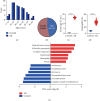TiO2-DNA Nanosensor In Situ for Quick Detection of Nasal Flora in Allergic Rhinitis Patients
- PMID: 35465013
- PMCID: PMC9020989
- DOI: 10.1155/2022/5708326
TiO2-DNA Nanosensor In Situ for Quick Detection of Nasal Flora in Allergic Rhinitis Patients
Retraction in
-
Retracted: TiO2-DNA Nanosensor In Situ for Quick Detection of Nasal Flora in Allergic Rhinitis Patients.Comput Math Methods Med. 2023 Jun 28;2023:9840370. doi: 10.1155/2023/9840370. eCollection 2023. Comput Math Methods Med. 2023. PMID: 37416246 Free PMC article.
Abstract
Background: A relevant study found that allergic rhinitis (AR) may be related to the imbalance of nasal flora. Therefore, if the nasal flora of AR patients can be detected quickly, it is of great significance to study the distribution law of nasal flora in AR patients and explore its correlation with AR.
Objective: To design a new and convenient nano-DNA sensor for quick screening of nasal flora in allergic rhinitis (AR) patients, so as to provide experimental basis for the prevention and treatment of AR.
Methods: We create a synthesized nanostructured DNA biosensor called Nano-TiO2-DNA sensor which can be combined with samples from nasal mucosa or secretion with high efficiency and detect certain flora in situ without DNA extraction or RNA sequencing. In a physical property test, firstly, we tested the permeability, solubility, and storage temperature of nano-TiO2, so as to provide experimental basis for the synthesis of Nano-TiO2-DNA sensor. Subsequently, the permeability of Nano-TiO2-DNA sensor in Staphylococcus aureus was further tested. In a clinical experiment, we selected 60 AR patients treated in our hospital from September 2020 to September 2021 as the AR group and 60 healthy people who underwent physical examination at the same time as the control group. The Nano-TiO2-DNA sensor was used to detect typical nasal flora in AR patients, and Pearson's correlation analysis was used to explore the correlation between nasal flora with serum IgE and eosinophils.
Results: As for physicochemical characteristics, this sensor can permeate into certain bacteria directly and specifically. It has high affinity ability with a target, and the combination can be detected by evaluating the released fluorescence qualitatively and quantitatively. It can be stored at -20°C in ethyl alcohol stably. By this sensor, we have successfully detected Staphylococcus aureus, Klebsiella pneumoniae, and viridans streptococci in AR patients compared with healthy people, which will help these patients in the prevention of acute sinusitis and acute or subacute pneumonia. Furthermore, we found Proteus had the strongest positive correlation with AR while Actinomyces had the biggest negative correlation.
Conclusion: The Nano-TiO2-DNA sensor will help an outpatient doctor more for quick screening certain nasal flora in AR patients and improve the prevention of AR-related complications.
Copyright © 2022 Weihua Chen et al.
Conflict of interest statement
The authors declare no competing interests.
Figures






Similar articles
-
[Analysis of nasal microbial characteristics in patients with allergic rhinitis and non-allergic rhinitis].Zhonghua Er Bi Yan Hou Tou Jing Wai Ke Za Zhi. 2023 Sep 7;58(9):885-891. doi: 10.3760/cma.j.cn115330-20221012-00605. Zhonghua Er Bi Yan Hou Tou Jing Wai Ke Za Zhi. 2023. PMID: 37675527 Chinese.
-
[Programmed cell death protein 1 and its ligands regulate immune balance in allergic rhinitis].Zhonghua Er Bi Yan Hou Tou Jing Wai Ke Za Zhi. 2020 Apr 7;55(4):384-390. doi: 10.3760/cma.j.cn115330-20190618-00392. Zhonghua Er Bi Yan Hou Tou Jing Wai Ke Za Zhi. 2020. PMID: 32306637 Chinese.
-
[To investigate the correlation of nasal secretions of eosinophils and lung function after the treatment of budesonide in the allergic rhinitis patients].Lin Chuang Er Bi Yan Hou Tou Jing Wai Ke Za Zhi. 2017 Apr 5;31(7):543-545. doi: 10.13201/j.issn.1001-1781.2017.07.012. Lin Chuang Er Bi Yan Hou Tou Jing Wai Ke Za Zhi. 2017. PMID: 29871306 Chinese.
-
[Local (exclusive) IgE production in the nasal mucosa. Evidence for local allergic rhinitis].HNO. 2013 Mar;61(3):217-23. doi: 10.1007/s00106-012-2584-0. HNO. 2013. PMID: 23241861 Review. German.
-
An Updated Review on Atrophic Rhinitis and Empty Nose Syndrome.Ear Nose Throat J. 2023 Jul 14:1455613231185022. doi: 10.1177/01455613231185022. Online ahead of print. Ear Nose Throat J. 2023. PMID: 37449389 Review.
Cited by
-
Retracted: TiO2-DNA Nanosensor In Situ for Quick Detection of Nasal Flora in Allergic Rhinitis Patients.Comput Math Methods Med. 2023 Jun 28;2023:9840370. doi: 10.1155/2023/9840370. eCollection 2023. Comput Math Methods Med. 2023. PMID: 37416246 Free PMC article.
References
-
- Korošec P., Šilar M., Kopač P., Eržen R., Zidarn M., Košnik M. Distinct contributory factors determine basophil-allergen sensitivity in grass pollen rhinitis and in anaphylactic wasp venom allergy. International Archives of Allergy and Immunology . 2016;171(2):89–101. doi: 10.1159/000452102. - DOI - PubMed
-
- Liu F., Li S., Gao C. Expression of serum YKL-40 in anaphylactic rhinitis patients and association of serum YKL-40 with serum IL-4 and IFN-γ. Lin Chung Er Bi Yan Hou Tou Jing Wai Ke Za Zhi . 2015;29(3):260–263. - PubMed
Publication types
MeSH terms
Substances
LinkOut - more resources
Full Text Sources
Research Materials

